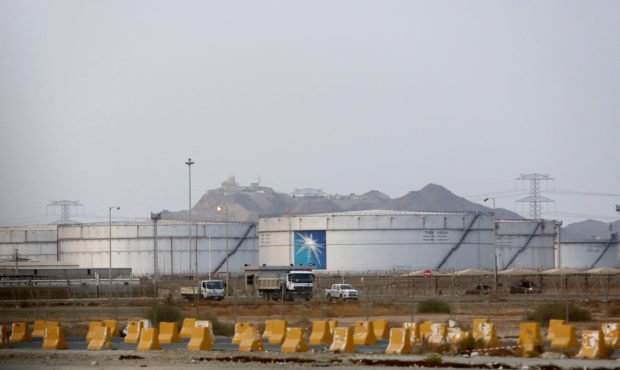An attack on Saudi Arabia’s largest oil processing plant pushed crude prices sharply higher Monday, though its longer-term impact depends on how long production is disrupted and the attack’s future implications.

Storage tanks are seen at the North Jiddah bulk plant, an Aramco oil facility, in Jiddah, Saudi Arabia, Sunday, Sept. 15, 2019. The weekend drone attack in Buqyaq on one of the world’s largest crude oil processing plants that dramatically cut into global oil supplies is the most visible sign yet of how Aramco’s stability and security is directly linked to that of its owner — the Saudi government and its ruling family. (AP Photo/Amr Nabil)
U.S. crude oil jumped $5.61 per barrel, or 10.2%, to $60.46 per barrel in electronic trading on the New York Mercantile Exchange. Brent crude, the international standard, surged $7.84 per barrel, or 13%, to $68.06 per barrel.
Yemen’s Iran-backed Houthi rebels claimed responsibility for the attack on the Saudi Aramco facility. It halted production of 5.7 million barrels of crude a day, more than half of Saudi Arabia’s global daily exports and more than 5% of the world’s daily crude oil production. Most output goes to Asia.
“To take Saudi oil production down 50%, that’s shocking,” said Jonathan Aronson, a research analyst at Cornerstone Macro.
The attack may add to anxiety about the stability of the world’s oil reserves. “Saudi Arabia has been a very reliable supplier of oil in the world,” said Jim Burkhard, who heads crude oil research for IHS Markit. This attack is “adding a geopolitical premium back into the price of oil.” That means oil prices would rise because of worries about more unrest hurting supply. Higher oil prices tend to hurt the economy as consumer costs rise.
Work is under way to restore production at the Abquaiq plant. The Wall Street Journal reported Sunday that Saudi officials said a third of crude output will be restored Monday, but bringing the entire plant back online may take weeks.
Officials said they would use other facilities and existing stocks to supplant the plant’s production.
The world’s richest countries have oil reserves of more than 2 billion barrels, but releasing those to alleviate supply concerns could potentially backfire and result in higher prices on the market as traders worry that there is a problem with tight supply, he said.
While the U.S. has a cushion because it and Canada both produce plenty, leaving the U.S. less reliant on oil from the Middle East, it’s still a global market. “If you take oil anywhere out of system it affects everybody,” said Burkhard.
Still, the situation is better today than it would have been a decade ago, prior to the U.S. energy boom.
If the plant goes back online and there is no fundamental change to the world’s supply of oil, prices may move higher and stay higher because traders would build in a “security premium,” said Michael Lynch, president of Strategic Energy & Economic Research.
There would be worries that the global oil supply is more insecure and that more attacks may be coming. And in a world already concerned about supply, the impact of another attack could mean a sharp effect on prices, said Kevin Book, managing director of Clearview Energy Partners. “It’s almost like an open season for a big attack.”
The attack on its oil infrastructure could lead Saudi Arabia to launch a military strike on Iran in retaliation, Book said. Countries attacking each other’s oil facilities and fields is a “prescription for a high oil price.” He argues that the attack on Saudi Arabia will help world markets finally recognize the repercussions of the unraveling of the Iran nuclear deal, from which President Donald Trump withdrew the U.S. in 2018, imposing harsh sanctions on Iran, including its oil industry. /gsg